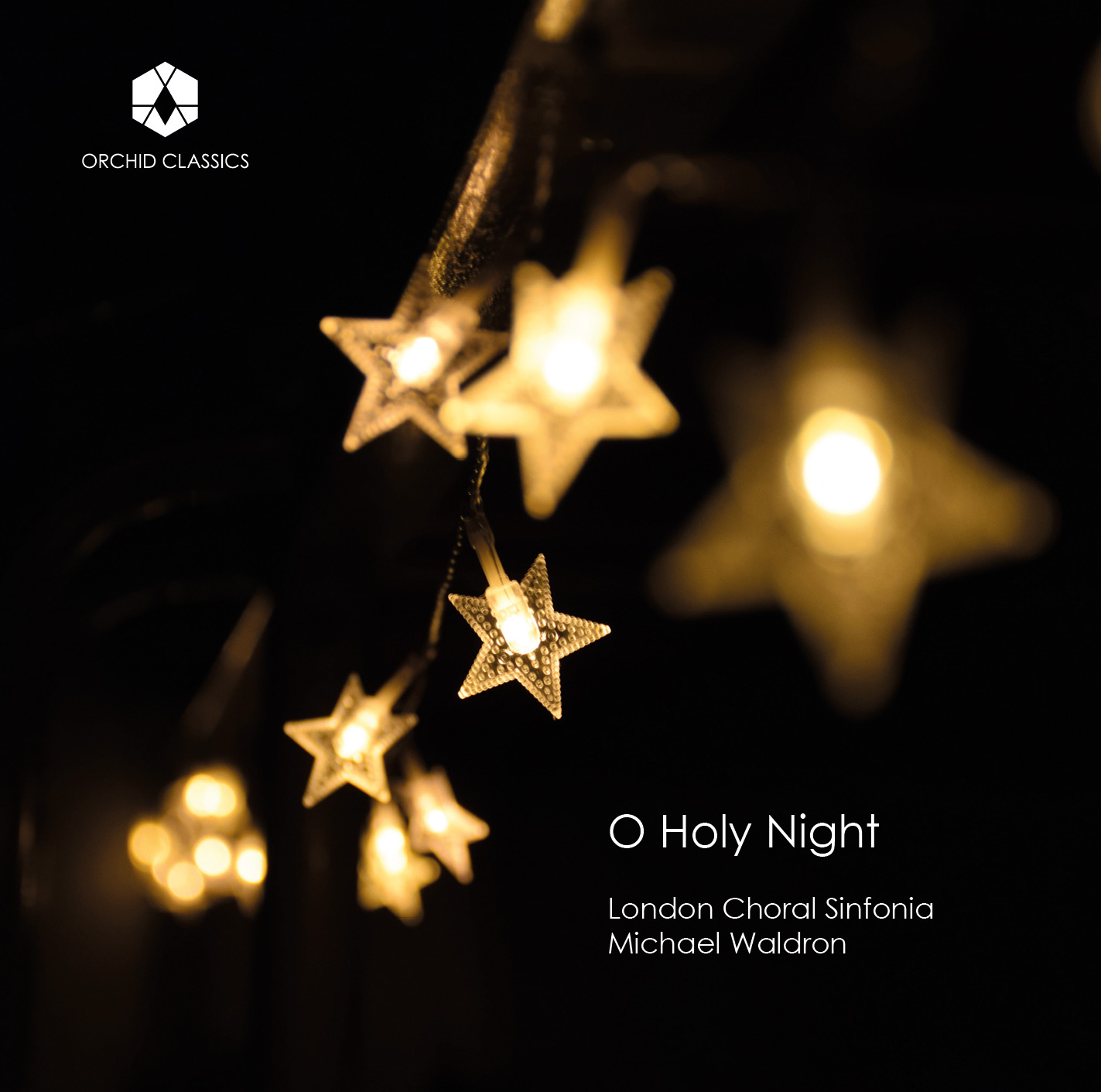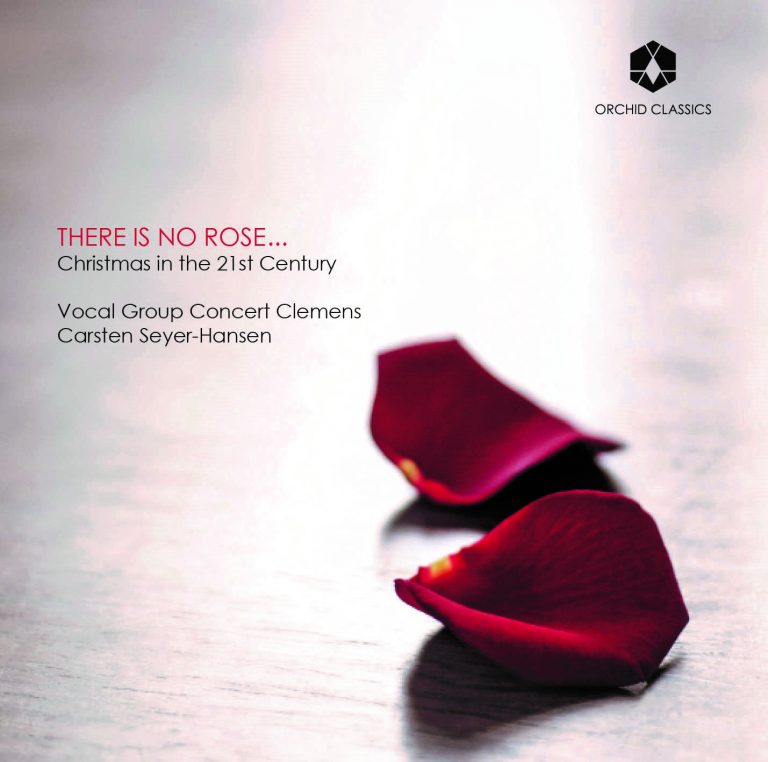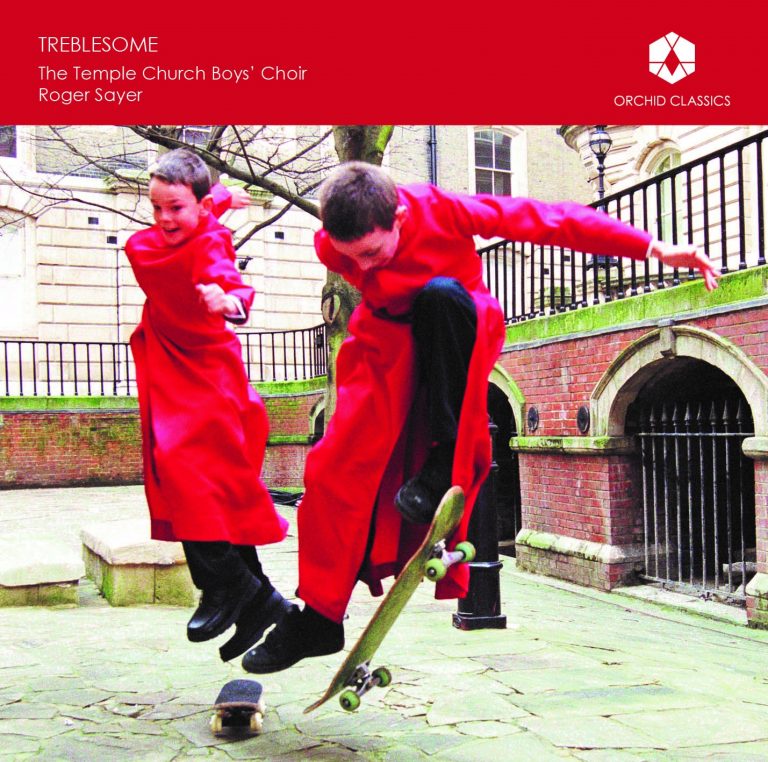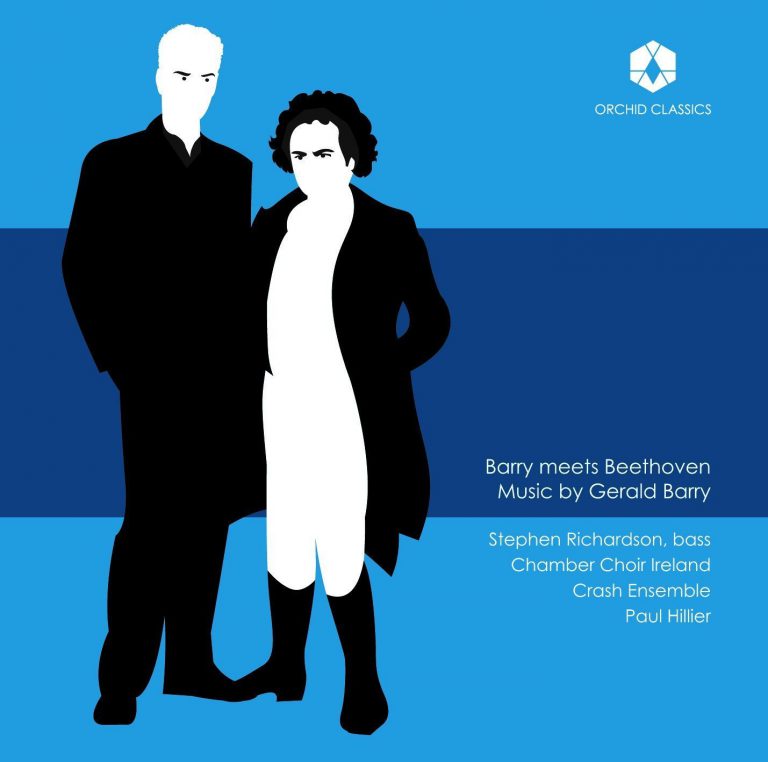Artist Led, Creatively Driven

O Holy Night
London Choral Sinfonia
Michael Waldron
Release Date: 15th November 2019
ORC100110
O HOLY NIGHT
1 O come, O come, Emmanuel
Traditional arr. Andrew Carter 4.00
2 Sir Christèmas
William Mathias 1.28
3 Lullay my Liking
Carol Canning 2.18
4 Silent Night (Solo: Katherine Watson)
Traditional arr. John West 3.27
5 Once in Royal David’s city (Solo: Charlotte Ashley)
H. J Gauntlett arr. David Willcocks 3.48
6 Adam Lay Ybounden (Solo: Zoë Brookshaw)
Peter Warlock 1.29
7 Alma Redemptoris Mater
Peter Maxwell Davies 3.07
8 A Christmas Carol
Richard Pantcheff 6.10
9 O Come, all ye Faithful
J. F Wade arr. David Willcocks 5.07
10 There is no rose
Thomas Wilson 4.46
11 The Child of Light
Robert Saxton 3.24
12 Coventry Carol
Jonathan Rathbone 4.00
13 Love came down at Christmas
Humphrey Clucas 2.21
14 We Three Kings
(Solos: Nick Pritchard, Dominic Kraemer, Samuel Pantcheff)
Martin Neary 3.15
15 No Small Wonder
Paul Edwards 2.49
16 Hark! the Herald Angels Sing
Mendelssohn arr. David Willcocks 3.12
17 The Holy Boy
John Ireland 2.43
18 O Holy Night (Solo: Katherine Watson)
Adolphe Adam arr. Max Pappenheim 6.27
19 Tomorrow go ye forth
Gabriel Jackson 2.35
20 Lo, He comes with clouds descending
Thomas Olivers arr. Max Pappenheim 5.03
Total time 71.53
London Choral Sinfonia
Michael Waldron
The world surely does not need another disc of Christmas music. When it became apparent that we might move forward with this LCS recording, I set out to find just about anything to record that was not Christmas repertoire. Despite this, and despite many hours of trawling through shelves of sheet music and CD catalogues, I kept coming back to the idea of compiling a slightly unusual and thought-provoking selection of exceptional Christmas music. It is a well-supplied area of recorded classical music, but one which I believe has a perfectly-sized gap for this recording.
The framework for the programme comes from the five traditional carols. Anyone who has ever sung a note of choral music or attended a carol concert around Christmas will be familiar with outstanding arrangements and descants by David Willcocks. My view is that recording these great carols has been somewhat overlooked by the finest professional choirs in favour of more erudite and virtuosic Christmas repertoire. They are synonymous with Christmas for so many of us and deserve tobe recorded at the very highest level. Andrew Carter’s electric arrangement of the advent carol O come, O come, Emmanuel still sends shivers down my spine, and is a worthy companion to the Willcocks legacy.
A similarly worthy companion is Max Pappenheim’s technicolour arrangement of Lo, He come with clouds descending. Max was Organ Scholar at Trinity College, Cambridge, and it was for the choir here he wrote and dedicated this arrangement. He and I overlapped there for just one year, but it was a year of great friendship and music making. Max’s arrangement was first performed at the 2006 Advent Carol Service, and has been included every subsequent year to date.
I approached Max about writing an arrangementof O Holy Night – by far my favourite carol – a few years later. The arrangement he produced (and recorded on this disc) far exceeded anything I could have hoped for. We discussed at length whether the climax – the top A for the soloist towards the very end of the piece – should be loud and dramatic, or hushed and mysterious. In the end we decided to have both, one after another!
Interspersed between the five carols is a selection of pieces I have collected over many years involved with numerous different choirs and many dozens of carol services and concerts along the way. Sir Christèmas and Adam Lay Ybounden will be known to many, but the rest, I believe, deserve to be better known. There is a mixture of works, from the less technically-demanding to the more virtuosic and challenging. I hope this selection may inspire, and offer welcomed discoveries to all listeners.
Michael Waldron
The tradition of Christmas carols goes back many centuries – in England, for instance, at least to the 14th century; but as this album amply demonstrates, new carols are constantly being written, while ancient and modern continue to interact.
Despite the ancient sources of both the text and music of the advent hymn ‘O come, O come, Emmanuel’ – the (originally) Latin text had its beginnings in a chant dating from the 8th century or earlier, while the music can be found in an unrelated 15th-century French manuscript – the two were not conjoined until the publication of the Hymnal Noted in 1851. An exciting feature of specialist choral composer Andrew Carter’s version are the dramatic cries of ‘Rejoice!’ which the arranger highlights to create a powerful climax.
Similarly, though the setting we hear by the distinguished Welsh composer William Mathiasdates from 1971, the text of the macaronic carol Sir Christèmas — snippets of French text are threaded through the English — goes back to the Ritson Manuscript, copied around 1510: Mathias enlivens his version with a striking use of cross rhythms.
Carol Canning joined The Swingle Singers while still a student at the Guildhall School of Music & Drama, going on to make regular arrangements for the celebrated group before eventually becoming its music director. She brings a subtle and personal touch to her close harmony setting of the Middle English lyric Lullay my Liking; particularly appealing is the open-ended close.
Among the best-known of all carols is Silent Night, a setting by Franz Xaver Gruber of lyrics by Joseph Mohr first sung in an Austrian village in 1818. Published in 1914, John West’s artful arrangement is the work of an organist and composer (1863-1929) who produced several cantatas for the Three Choirs Festival.
The legacy left by David Willcocks (1919–2015) in terms of his long association with such institutions as King’s College, Cambridge, and the Bach Choir is an enduring one, and many of his arrangements have become fixtures – including Once in royal David’s city, where his final verse adds grandeur to the melody by Henry John Gauntlett (1805–76) previously harmonized by organist Arthur Henry Mann (1850–1929).
Peter Warlock’s distinctive harmonic voice is characteristically memorable in his setting of the anonymous 15th-century carol Adam Lay Ybounden, originally set for voice and piano andhere arranged by Laurence H. Davies.
Peter Maxwell Davies described his Alma Redemptoris Mater as a ‘carol on a medieval text for four equal voices’, its main sections ‘rounds, each voice entering in turn and singing the verses once only and finishing in turn’.
The admired composer and conductor Richard Pantcheff (b.1959) divides his time between South Africa and the UK. In his atmospheric Swinburne setting A Christmas Carol, written in 2013 for the Choir of St George’s Anglican Church, Johannesburg, melodic ideas are underpinned by a slowly shifting rocking figure on the organ as they float through a kind of free musical space.
Like many carols, O Come, all ye Faithful has a complex history: though the Latin hymn’s origins are contentious, the familiar English text consists of elements from translations by Frederick Oakeley and William Thomas Brooke, while the melody was first published by John Francis Wade in 1751. Here the harmonies for the earlier verses are from the English Hymnal, while in the final verse David Willcocks’ descant provides a stirring conclusion.
The Scottish composer Thomas Wilson (1927–2001) produced music in all forms, some of it serial, though the rich and subtle modally inflected harmonies in his setting of the 15th-century anonymous Macaronic text (Latin and English) There is no rose belong to another tradition: there’s a particularly thrilling intervention from the angels and the shepherds.
Born in 1953, Robert Saxton set his own text for The Child of Light (1985), scored for sopranos and organ. Cluster chords amass while the voices chase one another around in canon, producing an effect of seeking something and then finally discovering it.
In arranging the Coventry Carol Jonathan Rathbone selected a well-known piece whose text originated in a medieval mystery play and whose melody goes back as far as 1591. Four hundred years later, the arranger – highly experienced in the field of choral music in particular – deploys some highly unusual harmonies to convey the violence of Herod’s slaughter of the innocents.
Born in 1941, Humphrey Clucas began his involvement with choral music as a choral scholarat King’s College, Cambridge, and was later appointed a lay vicar at Westminster Abbey: though he has contributed to other genres, it is his choral music that has become best known. Composed in 1995, his setting of Christina Rossetti’s text Love came down at Christmas is notable for its enriched harmony and fluidity.
Like David Willcocks, Martin Neary’s involvement with choral music has been lifelong. His arrangement of We Three Kings – words and music by John Henry Hopkins (1820-91) – was made as a processional carol for the choir and congregation of Winchester Cathedral, with each king represented by a soloist and the gleam of the ‘star of wonder’ depicted near the close by the organ’s trumpet stop.
As in the cases of several of the composers on this disc, Paul Edwards (born 1955) is steeped in the Anglican musical tradition, a former chorister and latterly an organist. There’s a firm sense of harmonic direction in his setting of Paul Wigmore’s
text No Small Wonder, written in 1983 and subsequently widely performed.
David Willcocks was responsible for the arrangement of Hark! The herald-angels sing, words by Charles Wesley, and melody and harmony adapted by W. H. Cummings (1831–1915) from a chorus in Mendelssohn’s Festgesang in praise of Gutenberg; once again he brings the final verse to a triumphant conclusion.
John Ireland is best remembered for his varied output of piano music and songs, and indeed it was as a piano work that The Holy Boy – A Carol first appeared in print in 1915. It quickly became popular, and Ireland himself made various arrangements, including this one for the BBC Singers in 1941, to words by Herbert S. Brown.
O Holy Night has a complex history. Originally composed to a text by Placide Cappeau by the French composer Adolphe Adam (1803–56: best known for the ballet Giselle), it has been translated into many languages, including into English by Unitarian minister John Sullivan Dwight.
Sound designer and composer Max Pappenheim is especially renowned for his work in the theatre. He made the present arrangement for soprano Katherine Watson, conductor Michael Waldron and the London Choral Sinfonia, and in it included brief references to other Christmas carols – see if you can spot them all!
A prolific choral composer, Gabriel Jackson was commissioned by the Dean and Chapter of Norwich Cathedral to produce a Vesper Respond for Advent Sunday for organist Michael Nicholas and the Cathedral Choir; from the score we learn that the striking Tomorrow go ye forth was written in Baron’s Court between 5 and 15 November 1992.
Pappenheim is again the arranger of Lo, he comes with clouds descending, its second verse containing an expressive touch in the soprano descant at the phrase ‘deeply wailing’, while the more elaborate later verses lead to a resplendent close.
George Hall
Michael Waldron
Conductor
Michael Waldron began his musical training as a chorister at St Ambrose College, Hale Barns. After a gap year Organ Scholarship at Worcester Cathedral, he held the Organ Scholarship at Trinity College, Cambridge, for four years. Here he studied under Stephen Layton, during which time he was involved with the Choir’s numerous international tours, concerts, broadcasts and recordings.
Since graduating, Michael has quickly established himself as one of the most dynamic and versatile conductors of his generation, enjoying a busy concert career. He has worked with the Philharmonia Orchestra, Hamburg Symphony Orchestra, Royal Philharmonic Orchestra, Britten Sinfonia, Academy of Ancient Music, Orchestra of the Age of Enlightenment, Polyphony, London Mozart Players and Tonbridge Philharmonic, including appearances at the Royal Albert Hall, Royal Festival Hall, Queen Elizabeth Hall, Cadogan Hall, Wigmore Hall and BBC Proms.
Michael enjoys an extensive operatic career, including shows and projects for the Royal Opera House, English National Opera, Buxton International Festival, Opera Della Luna and West Green Opera.
He is currently Artistic Director of the London Choral Sinfonia, London Lyric Opera, Islington Choral Society, Epworth Choir, and has also held posts with Guildford Choral Society and University of West London Chamber Choir.
Katherine Watson
Soprano
British soprano Katherine Watson started her career as young artist in Le Jardin des Voix. She has since appeared with many leading conductors including Emmanuelle Haim, Hervé Niquet, Laurence Cummings, Harry Christophers, and Raphaël Pichon, and continues to work internationally with William Christie and Les Arts Florissants.
Katherine was awarded Glyndebourne’s coveted John Christie Award and subsequently performed as Diana Hippolyte et Aricie atthe festival. Opera highlights since then include Iphis Jephtha at the Opéra National de Paris, Theodora at the Théâtre des Champs-Elysées, Armelite Zoroastre at Komischer Oper, Cassandra La Didone in Caen, Luxembourg and Paris, and appearances at Teatro Real, Opera Comique and Opéra National de Bordeaux.
Katherine enjoys a busy concert career with notable performances including Handel and Pergolesi with the Orchestra of the Age of Enlightenment, French baroque music with Le Concert d’Astrée and Les Ambassadeurs, Handel’s Messiah with the Royal Liverpool Philharmonic Orchestra, the BBC National Orchestra of Wales, and appearances at the Carnegie Hall, the Wigmore Hall and the BBC Proms.
Prominent recordings include L’Opéra du Roi Soleil (solo recording, Alexis Kossenko/Les Ambassadeurs), Bach’s Christmas Oratorio (Layton/OAE), Handel’s Messiah (Niquet/Le Concert Spirituel), Monteverdi Madrigals (Jonathan Cohrcangelo) and the title role in Theodora (Warner Classics).









